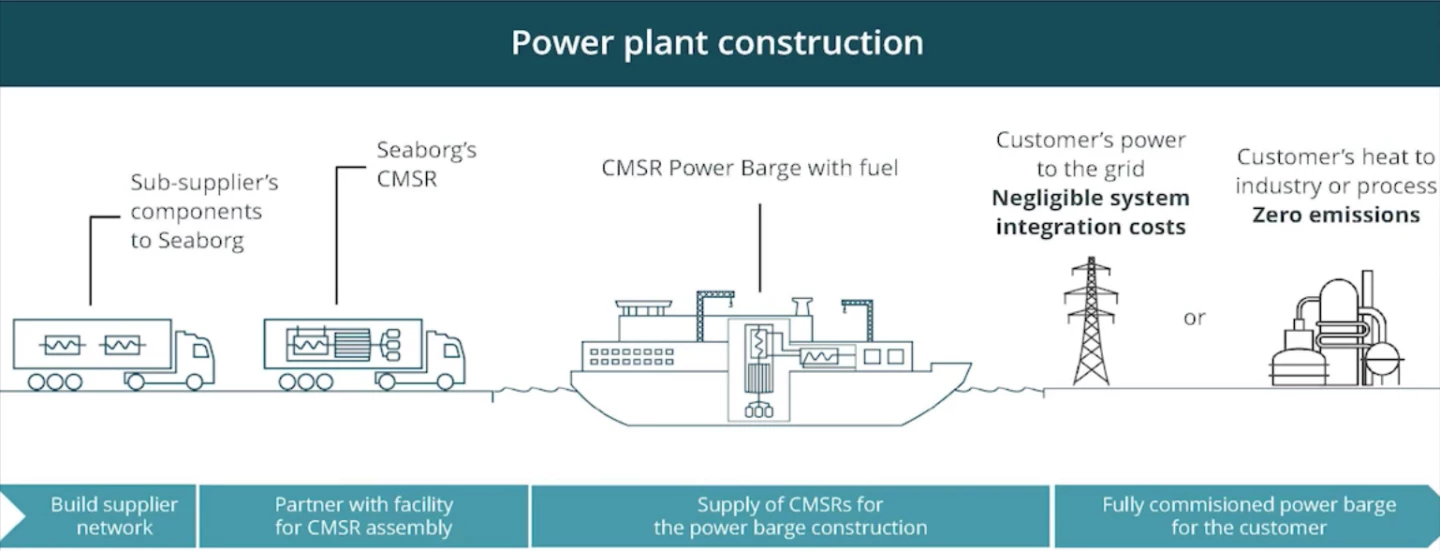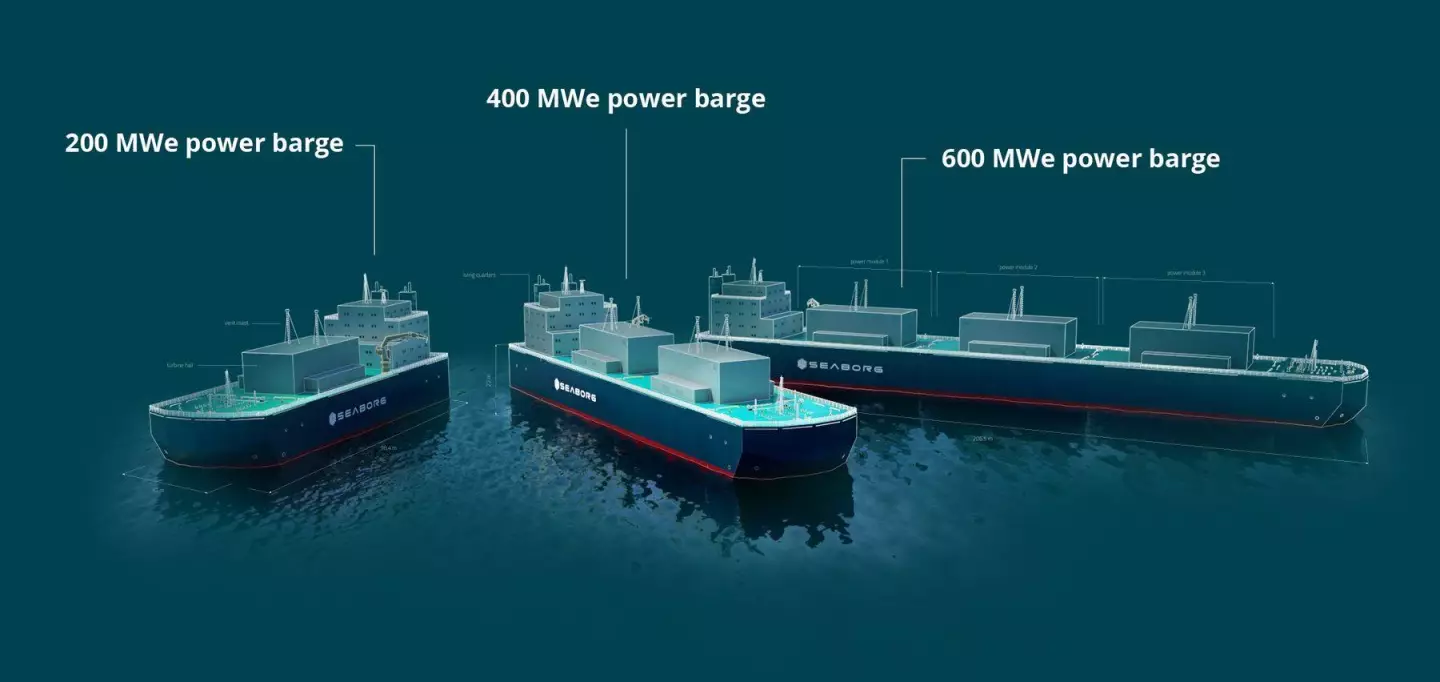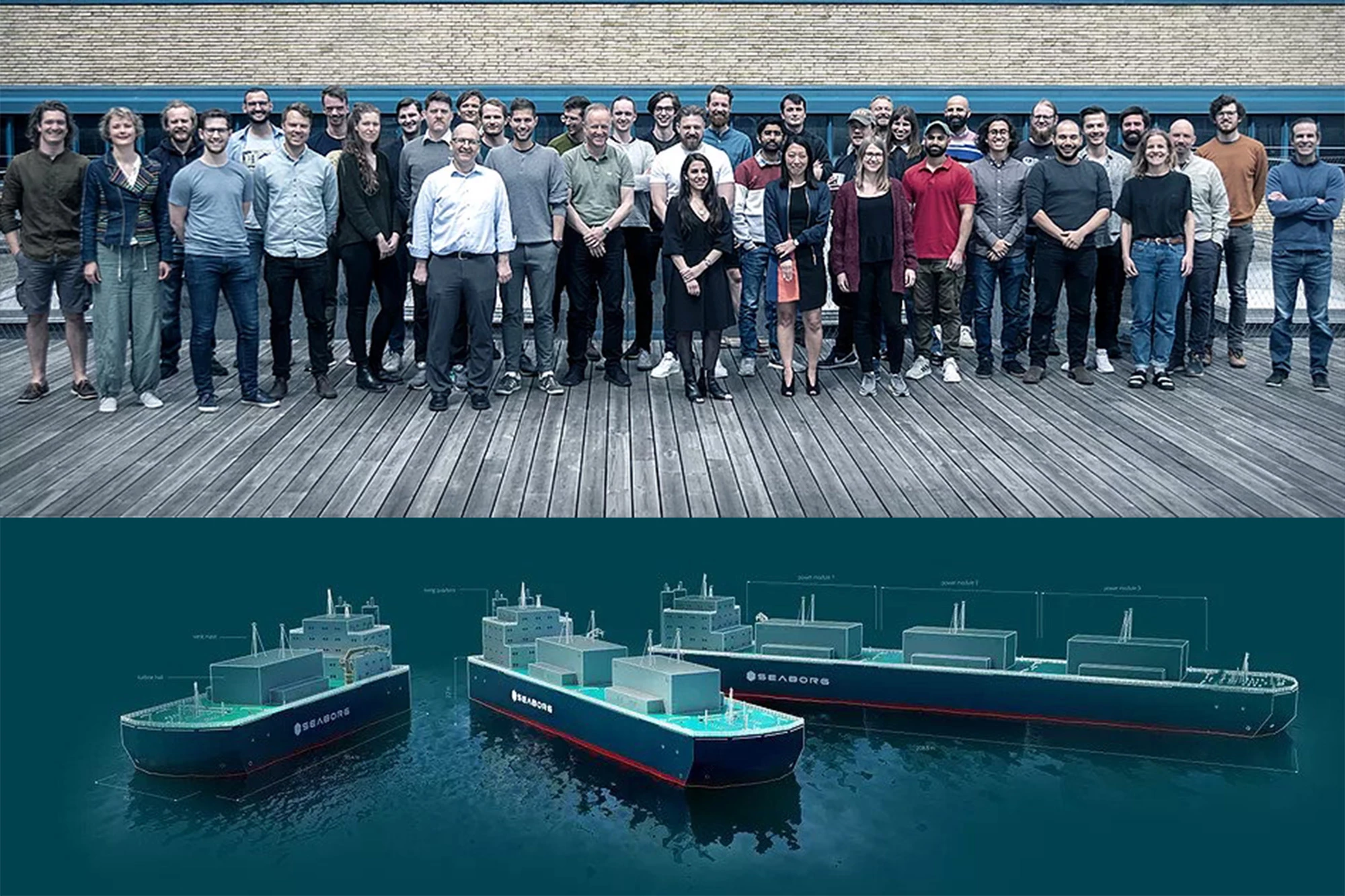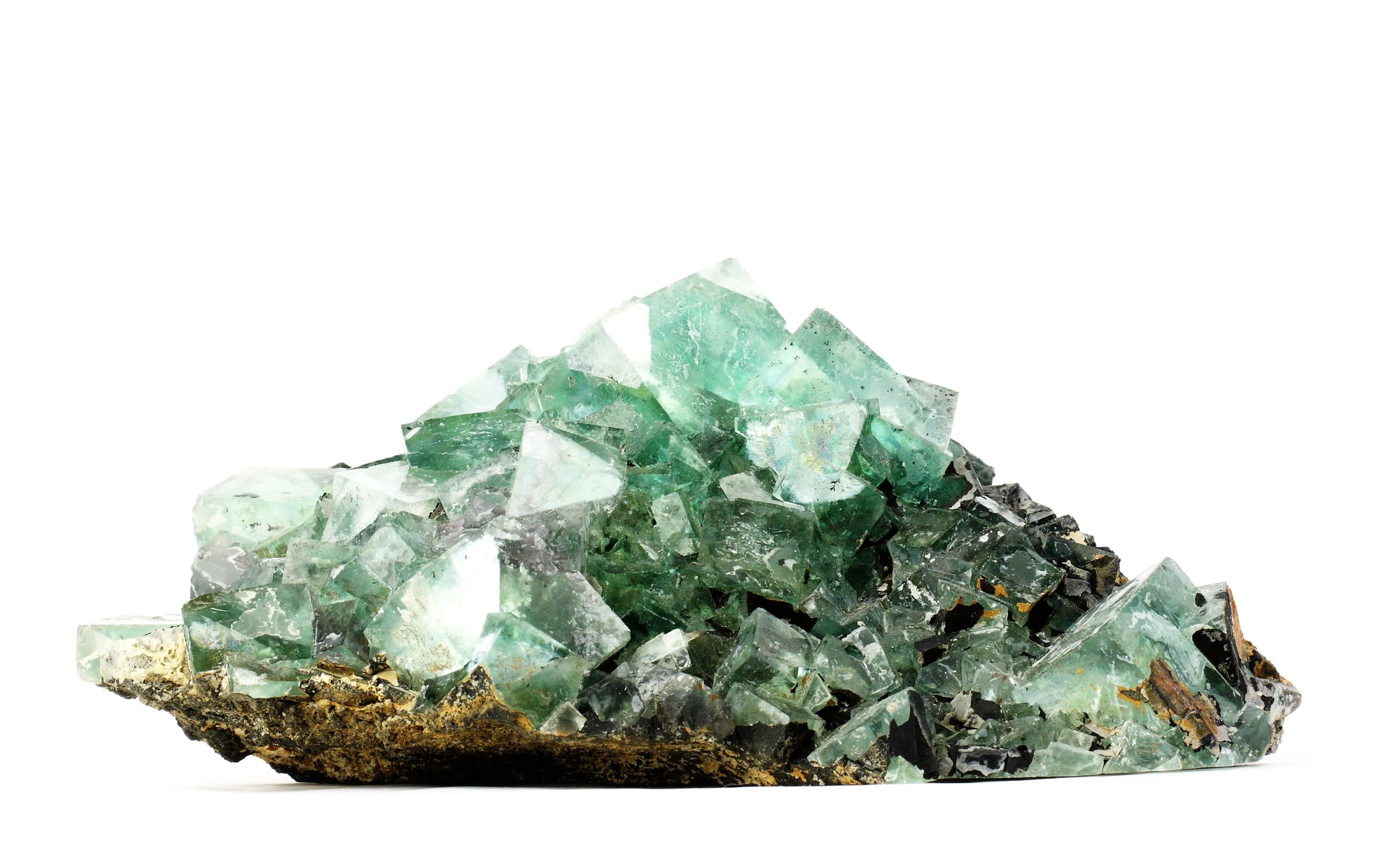Copenhagen startup Seaborg Technologies has raised an eight-figure sum of Euros to start building a fascinating new type of cheap, portable, flexible and super-safe nuclear reactor. The size of a shipping container, these Compact Molten Salt Reactors will be rapidly mass-manufactured in their thousands, then placed on floating barges to be deployed worldwide – on timelines that will smash paradigms in the energy industry.
Like other molten salt reactors, which have been around since the 1950s, they're designed to minimize the consequences of accidents, with a pair of very neat passive safety measures the company claims can greatly change the safety equation at the heart of any nuclear power investment.
Firstly, they use nuclear fuel that's mixed into fluoride salts. The combination is liquid above 500 °C (932 °F), allowing it to flow through the reactor, which operates at near-atmospheric pressures. This liquid salt functions as a coolant for the nuclear fuel, replacing the high-pressure water cooling in older reactor designs. But if this fuel is exposed to air, instead of venting explosively as steam, it acts like lava and solidifies into rock.
Yes, the rock is radioactive, and you shouldn't go have a picnic on it, but it's not a cloud of radioactive gas that can blow across the continent; it's solid rock that can be cleaned up by safety teams with Geiger counters. It also has very low solubility in water, so it's comparatively safe even if it falls into the sea.

Secondly, if temperature starts getting out of control for some reason, a "frozen salt" plug at the bottom of the reactor is the first thing that'll melt, and this will immediately drain the reactor core into a series of cooled drainage tanks underneath.
This pair of simple measures, says Seaborg Technologies co-founder and CEO Troels Schönefeldt, radically re-focuses the nuclear safety question away from total accident prevention with four layers of redundancy at every point of failure, to much simpler consequence mitigation, and it'll have a huge impact on the cost of nuclear power.
"We take a different approach," he told Radio Spectrum in an interview. "We’re not reducing the likelihood of an accident to zero, there will be accidents. We should avoid them as much as we can, but there will be accidents. Hopefully, there will be a lot of accidents because we will have a lot of these reactors. What we do, instead of reducing the likelihood, is reduce the consequence of even the worst disasters. Or even acts of war where you actually bomb the reactor. The consequence there is that this fluoride salt will flow out of the reactor, or explode out of the reactor, and lie on the field. It’ll solidify. And now you shouldn’t go onto that field. You should actually keep 10 or 20 feet of distance. But you can go there with a Geiger counter and clean it up. It’s wildly expensive, but you can do it. And that changes the fundamental safety profile of the technology. And in doing so, we change the cost, which again, in turn changes the business model."

But perhaps the most impactful change to the business model is Seaborg's proposal to install these reactors on barges, and float them offshore rather than buying up land to develop nuclear power plants. There are several advantages here. For starters, you can manufacture them in bulk at a single facility. Seaborg is looking at Korean shipyards, which are already closely and efficiently connected to supply chains with enormous production capacity.
"If you want us to build not one reactor to start with, but a thousand, we could start by building a thousand," Schönefeldt told Radio Spectrum. "That will take, like, three or four years on these shipyards. So it’s basically unroofed in how fast you can scale it."
These barges can be moved just about anywhere on the planet, either moored offshore or on large or small rivers, depending on how big a reactor it is. There's virtually no site preparation required; it's fully self-contained and very easy to connect to a power grid. Seaborg estimates it can service 95 percent of the world's population this way, putting basically no land requirements on a baseload or load-following power station up to a healthy 600 MW, which could supply nearly 100,000 homes.

The challenge here, as with all molten salt reactors, is corrosion. Hot molten salt itself is highly corrosive, and this will be a serious challenge to design around for every component that comes into contact with the fuel salt. Float the reactors on barges in salty seawater, and you expose the entire exterior to a powerful corrosive agent as well; cargo ships are typically designed with a 25-year service life in mind thanks to the effects of life in salt water.
And it doesn't stop there for Seaborg. Other molten salt reactors use graphite as a moderator, slowing down the neutrons produced by each fission reaction to maintain the chain reaction. But graphite tends to fracture and weaken when exposed to intense radiation with repeated heating and cooling, eventually resulting in what Seaborg co-founder and CTO Eirik Eide Pettersen describes to Thomas Thor Associates as "unacceptable hotspots."
Seaborg's solution is to use another molten salt – sodium hydroxide – as a liquid moderator. Thus, the core design places the fuel salt tube inside a larger tube filled with sodium hydroxide, creating a first-of-its-kind all-liquid reactor that's remarkably compact. But sodium hydroxide itself is a powerfully caustic base, often used as oven cleaner or drain cleaner; the Seaborg design has to deal with this added corrosive agent too.
And on top of all that, there's the freaky phenomenon of "grain-boundary corrosion" to boot, caused by the presence of tellurium as a fission by-product in the fuel salt stream. Tellurium atoms can merrily penetrate through metals, and swap positions with other elements, leading to embrittlement of the metals at their weakest points.
The company is well aware of its key challenges here. "Seaborg’s core IP is based on corrosion control in the moderator salt, and applying the lessons learned since the 1950s," says Pettersen. "But it is not just a question of corrosion, it is also how easy it is to put these things together. Hands-on experience is important. They need to be welded, tested, inspected, maintained. We are working towards having perhaps 20 or 30 test loops in Copenhagen, with the experiments designed, set up and executed. The conceptual design is already done; we are now working on the basic design and in that way we are working up towards a full-scale prototype."

That full-scale prototype is currently scheduled to go online in 2025, at which point it'll likely be sent to work off an island in Southeast Asia. Having raised some reasonably substantial capital, Seaborg is hiring like mad to work toward that goal. It hopes to achieve regulatory type approval for its design by 2026, and commercial serial production could follow as early as 2027.
These timelines are "almost insane" in the energy market, Schönefeldt told the Switch 2020 audience in a presentation earlier this year, and a validation of the mass production strategy and floating barge approaches. Energy industry investors, who are used to dealing with extremely long planning and construction phases, as well as multi-decade return on investment periods, can now put their money into something that's online incredibly rapidly and paying for itself within 6-10 years.
The Seaborg reactor is small enough to fit in a shipping container, making it remarkably easy to move around even for ground installations. It'll run for around 12 years without refueling. Its fuel cannot be used in nuclear weapons. It's capable of being run on refined, recycled nuclear waste from older reactors – although there will be some regulatory hurdles there, says Schönefeldt. You can draw heat straight from the reactor even more efficiently than drawing electricity, so it'll be useful in ways other than just being a power station.
Next-generation advanced nuclear power is a hot topic at the moment. With global resolve hardening around the target of zero carbon emissions by 2050, coal- and gas-fired power stations are rapidly being retired. Renewable resources like solar and wind energy will provide the bulk of the energy we'll need moving forward, but nuclear offers a reliable, cheap and green way to bolster the base load and fill in gaps when renewables aren't generating.
Despite some extremely high-profile catastrophes, nuclear is already by far the safest method of power generation, with a "deathprint" 330 times lower than coal-fired electricity. The new generation of advanced nuclear reactors promises to be even safer, and molten salt designs like Seaborg's can dramatically lower the consequences of those vanishingly rare incidents as well. If this company can solve the corrosion issues as effectively as its investors believe it can, what an enormous game-changer this could be.
Source: Seaborg Technologies via IEEE Spectrum, Thomas Thor Associates and Switch 2020










